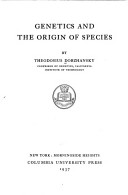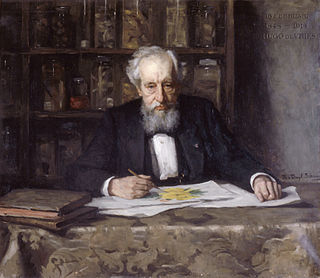
Theodosius Grygorovych Dobzhansky was a prominent Ukrainian-American geneticist and evolutionary biologist, and a central figure in the field of evolutionary biology for his work in shaping the modern synthesis. Dobzhansky was born in Ukraine, then part of the Russian Empire, and became an immigrant to the United States in 1927, aged 27.

The modern synthesis was the early 20th-century synthesis reconciling Charles Darwin's theory of evolution and Gregor Mendel's ideas on heredity in a joint mathematical framework. Julian Huxley coined the term in his 1942 book, Evolution: The Modern Synthesis.

Evolutionary biology is the subfield of biology that studies the evolutionary processes that produced the diversity of life on Earth. Simply, it is also defined as the study of the history of life forms on Earth. In the 1930s, the discipline of evolutionary biology emerged through what Julian Huxley called the modern synthesis of understanding, from previously unrelated fields of biological research, such as genetics and ecology, systematics, and paleontology. A person who studies Evolutionary biology is called an Evolutionary biologist. The importance of studying Evolutionary biology is mainly to understand the principles behind the origin and extinction of species.

In biology, polymorphism is the occurrence of two or more clearly different morphs or forms, also referred to as alternative phenotypes, in the population of a species. To be classified as such, morphs must occupy the same habitat at the same time and belong to a panmictic population.

This is a list of topics in evolutionary biology.

Genetics and the Origin of Species is a 1937 book by the Ukrainian-American evolutionary biologist Theodosius Dobzhansky. It is regarded as one of the most important works of the modern synthesis, and was one of the earliest. The book popularized the work of population genetics to other biologists, and influenced their appreciation for the genetic basis of evolution. In his book, Dobzhansky applied the theoretical work of Sewall Wright (1889–1988) to the study of natural populations, allowing him to address evolutionary problems in a novel way during his time. Dobzhansky implements theories of mutation, natural selection, and speciation throughout his book to explain habits of populations and the resulting effects on their genetic behavior. The book explains evolution in depth as a process over time that accounts for the diversity of all life on Earth. The study of evolution was present, but greatly neglected at the time. Dobzhansky illustrates that evolution regarding the origin and nature of species during this time in history was deemed mysterious, but had expanding potential for progress to be made in its field.

George Ledyard Stebbins Jr. was an American botanist and geneticist who is widely regarded as one of the leading evolutionary biologists of the 20th century. Stebbins received his Ph.D. in botany from Harvard University in 1931. He went on to the University of California, Berkeley, where his work with E. B. Babcock on the genetic evolution of plant species, and his association with a group of evolutionary biologists known as the Bay Area Biosystematists, led him to develop a comprehensive synthesis of plant evolution incorporating genetics.

Mutationism is one of several alternatives to evolution by natural selection that have existed both before and after the publication of Charles Darwin's 1859 book On the Origin of Species. In the theory, mutation was the source of novelty, creating new forms and new species, potentially instantaneously, in sudden jumps. This was envisaged as driving evolution, which was thought to be limited by the supply of mutations.
Edgar Shannon Anderson was an American botanist. His 1949 book Introgressive Hybridization was an original and important contribution to botanical genetics.
Systematics and the Origin of Species from the Viewpoint of a Zoologist is a book written by zoologist and evolutionary biologist Ernst Mayr, first published in 1942 by Columbia University Press. The book became one of the canonical publications on the modern synthesis and is considered to be exemplary of the original expansion of evolutionary theory. The book is considered one of his greatest and most influential.

In biology, saltation is a sudden and large mutational change from one generation to the next, potentially causing single-step speciation. This was historically offered as an alternative to Darwinism. Some forms of mutationism were effectively saltationist, implying large discontinuous jumps.
The following outline is provided as an overview of and topical guide to genetics:

Julian Huxley used the phrase “the eclipse of Darwinism” to describe the state of affairs prior to what he called the modern synthesis, when evolution was widely accepted in scientific circles but relatively few biologists believed that natural selection was its primary mechanism. Historians of science such as Peter J. Bowler have used the same phrase as a label for the period within the history of evolutionary thought from the 1880s to around 1920, when alternatives to natural selection were developed and explored—as many biologists considered natural selection to have been a wrong guess on Charles Darwin's part, or at least as of relatively minor importance. An alternative term, the interphase of Darwinism, has been proposed to avoid the largely incorrect implication that the putative eclipse was preceded by a period of vigorous Darwinian research.

Plant evolution is the subset of evolutionary phenomena that concern plants. Evolutionary phenomena are characteristics of populations that are described by averages, medians, distributions, and other statistical methods. This distinguishes plant evolution from plant development, a branch of developmental biology which concerns the changes that individuals go through in their lives. The study of plant evolution attempts to explain how the present diversity of plants arose over geologic time. It includes the study of genetic change and the consequent variation that often results in speciation, one of the most important types of radiation into taxonomic groups called clades. A description of radiation is called a phylogeny and is often represented by type of diagram called a phylogenetic tree.

Evolutionary thought, the recognition that species change over time and the perceived understanding of how such processes work, has roots in antiquity—in the ideas of the ancient Greeks, Romans, and Chinese as well as in medieval Islamic science. With the beginnings of modern biological taxonomy in the late 17th century, two opposed ideas influenced Western biological thinking: essentialism, the belief that every species has essential characteristics that are unalterable, a concept which had developed from medieval Aristotelian metaphysics, and that fit well with natural theology; and the development of the new anti-Aristotelian approach to modern science: as the Enlightenment progressed, evolutionary cosmology and the mechanical philosophy spread from the physical sciences to natural history. Naturalists began to focus on the variability of species; the emergence of paleontology with the concept of extinction further undermined static views of nature. In the early 19th century Jean-Baptiste Lamarck (1744–1829) proposed his theory of the transmutation of species, the first fully formed theory of evolution.

The following outline is provided as an overview of and topical guide to evolution:

The extended evolutionary synthesis consists of a set of theoretical concepts argued to be more comprehensive than the earlier modern synthesis of evolutionary biology that took place between 1918 and 1942. The extended evolutionary synthesis was called for in the 1950s by C. H. Waddington, argued for on the basis of punctuated equilibrium by Stephen Jay Gould and Niles Eldredge in the 1980s, and was reconceptualized in 2007 by Massimo Pigliucci and Gerd B. Müller.

Frank Harlan Lewis, known professionally as Harlan Lewis, was an American botanist, geneticist, taxonomist, systematist, and evolutionist who worked primarily with plants in the genus Clarkia. He is best known for his theories of "catastrophic selection" and "saltational speciation", which are closely aligned with the concepts of quantum evolution and sympatric speciation. The concepts were first articulated in 1958 by Lewis and Peter H. Raven, and later refined in a 1962 paper by Lewis in which he coined the term "catastrophic selection". In 1966, he referred to the same mechanism as "saltational speciation".

The scientific study of speciation — how species evolve to become new species — began around the time of Charles Darwin in the middle of the 19th century. Many naturalists at the time recognized the relationship between biogeography and the evolution of species. The 20th century saw the growth of the field of speciation, with major contributors such as Ernst Mayr researching and documenting species' geographic patterns and relationships. The field grew in prominence with the modern evolutionary synthesis in the early part of that century. Since then, research on speciation has expanded immensely.

Invasion genetics is the area of study within biology that examines evolutionary processes in the context of biological invasions. Invasion genetics considers how genetic and demographic factors affect the success of a species introduced outside of its native range, and how the mechanisms of evolution, such as natural selection, mutation, and genetic drift, operate in these populations. Researchers exploring these questions draw upon theory and approaches from a range of biological disciplines, including population genetics, evolutionary ecology, population biology, and phylogeography.













